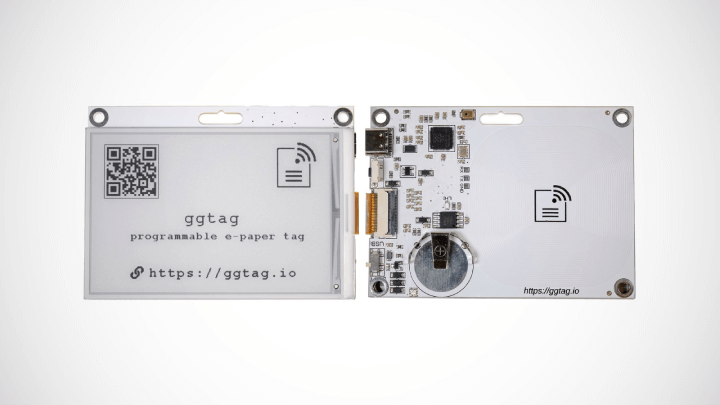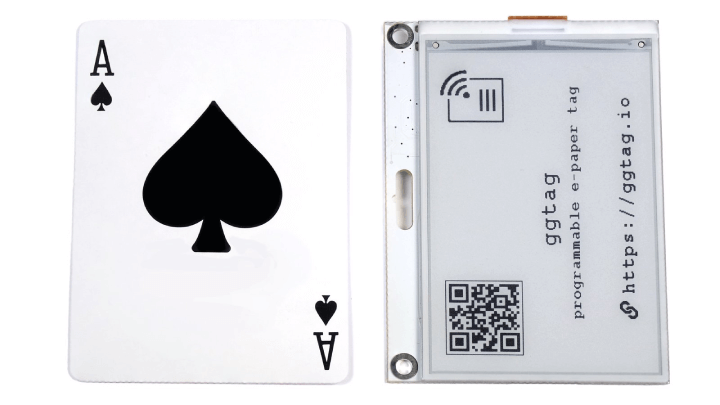GGtag: The Reusable & Reprogrammable ePaper Badge Tackling E-Waste
Insights | 24-07-2023 | By Robin Mitchell
In a world of consumption and waste, it is amazing to see how copious amounts of technology quickly find their way into landfills with little regard for recycling. Recognising the waste caused by ID cards, Eurolan has demonstrated a new ePaper-based ID card that is reprogrammable and reusable. What challenges does e-waste present, what is GGtag, and is this technology a step in the right direction?

What challenges does e-waste present?
There can be no question of the brilliance of mankind; we have manipulated our environment to suit us, we have extracted the rarest of minerals from the earth’s crust, and we have even put humans on the moon. And yet, for all our brilliance, we have undoubtedly had a negative impact on the environment, having destroyed vast amounts of rainforests, polluted the oceans, and even introduced microplastics into food chains that may carry carcinogenic risks.
The electronics industry is no different in this shame, and every year, vast amounts of electronics find their way into landfills, never to be recycled. But why exactly is this the case?
The problem with electronic waste is not simple, and when understanding the history of electronics, it is very easy to be sympathetic to the generation of waste. When the first electronic devices were manufactured (think early radios and TVs), developments in the field of electronics were slow. Vacuum tubes could only be made so small, components were expensive, and the economic depression following two world wars saw electronic equipment well used and well maintained.
However, the invention of the transistor fundamentally changed electronics, allowing researchers to rapidly develop new technologies and shrink the size of devices. This resulted in a long-lasting market environment where electronic devices quickly became outdated as newer technologies allowed for longer battery life, increased performance, and smaller sizes.
Compounding this rapid speed of development with a strong capitalist market, the end result is a cycle whereby newly developed technologies encourage new devices, which in turn drives sales, and those sales encourage further research.
But this rapid cycle of development and production leads to all kinds of challenges, especially around the environment. For example, the increased need for rare earth minerals requires large mining operations that produce highly toxic by-products, and as many of these mines are generally in economically deprived countries with poor government legislation and enforcement, local wildlife and populations can be massively harmed by such activities.
Once the needed minerals have been gathered, they need to be turned into electronic devices, and such processes alone can consume vast quantities of water, produce tons of CO2, and require huge amounts of energy. After those devices have been used and disposed of, unless they can be recycled, all the minerals found in those devices (which are often toxic) can easily leak into landfills and eventually find their way into the surrounding soil and underground water sources.
Overall, the damage caused by electronics goes well beyond the immediate threat of devices in landfills, and the entire supply chain, from the raw materials to eventual disposal, can contribute to long-lasting environmental damage.
GGtag – A reusable and reprogrammable ePaper-based badge
Recently, a networking equipment company called Eurolan recently announced a new badge that allows users to not only reuse them but reprogram them when given to someone else. The idea behind the badge is to try and reduce the amount of e-waste from RFID lanyards that commonly find themselves throwaway while simultaneously demonstrating how electronics can be used to create devices that last.
The new badge is made from a large e-paper display that makes the badge appear to be printed like traditional badges. At the same time, an RP2040 provides programmability and configuration, while a small lithium-ion battery provides power when the badge is used to access secure areas and reprogram the display. By using an e-paper display, the badge can retain images without power, thereby extending the battery life.
Additionally, the integration of RFID allows for the badge to be used like normal lanyards, and this system is powered by a Microchip ATiny85 that emulates an RFID chip. Finally, the badge can be programmed via USB as well as sound with the use of FSK tones. This allows multiple tags to be prograde simultaneously at data rates of 16 bytes per second.
The GGtag's underlying technology, GGwave, is a sophisticated method of data transmission that encodes data as different audio tones. It splits the data into four-bit chunks and uses 16 different frequency offsets to represent each possible value. Each chunk is added to one of six different base frequencies, allowing the receiving device to determine which chunk it's processing. This method of data transmission is reminiscent of the phone modems of old but with a modern twist. (source)

At this stage, the badge is still in development, and a Crowd Supply campaign will soon be started to try and get the badge out into the public space.
For more technical details about the GGtag, you can visit the official project page on Crowd Supply, the company's website, or the GGwave library on GitHub. The hardware directory on GitHub also provides valuable information about the GGtag's hardware design.
Is this technology a step in the right direction?
There is no doubt that this badge is several orders of magnitude more expensive than cheap plastic alternatives with RFID chips built into them, and yet, it is this kind of product that just might help to sow the seeds that eventually spring into a new mindset around electronics. Just because plastic RFID cards are cheaper doesn’t mean that they should be used; it’s very similar to disposable plastic cutlery and straws that may be cheap but are highly damaging to the environment.
As noted by experts on Hackaday, "for a simple notification, a few bytes of data, a URL, or some configuration parameters, we can see this being a great software addition to any device that has a speaker and/or microphone." This expert opinion underscores the potential of the GGtag and similar technologies to contribute to a more sustainable future in electronics.
Novelty items, such as the GGtag, could eventually inspire other engineers to create devices designed to be reused and reprogrammed. From there, a whole industry of recycled electronics and reusability could help push the electronics industry in the direction of sustainability.
So, will the GGtag be successful? While it's more likely to be seen as a novelty item rather than something that is truly practical, it's undeniable that it represents a fascinating concept. Engineers and innovators are known for their ability to take a concept and transform it into something revolutionary. The GGtag, with its reusability and re-programmability, could be the seed that inspires a wave of sustainable electronic devices.
But the question remains: Are we ready to embrace such a change? Are we willing to invest in more expensive yet sustainable alternatives to cheap, disposable electronics? The answer to these questions will determine not only the success of the GGtag but also the future of our environment. As consumers, we have the power to drive the demand for sustainable electronics and shape the industry's direction. Let's use that power wisely.

